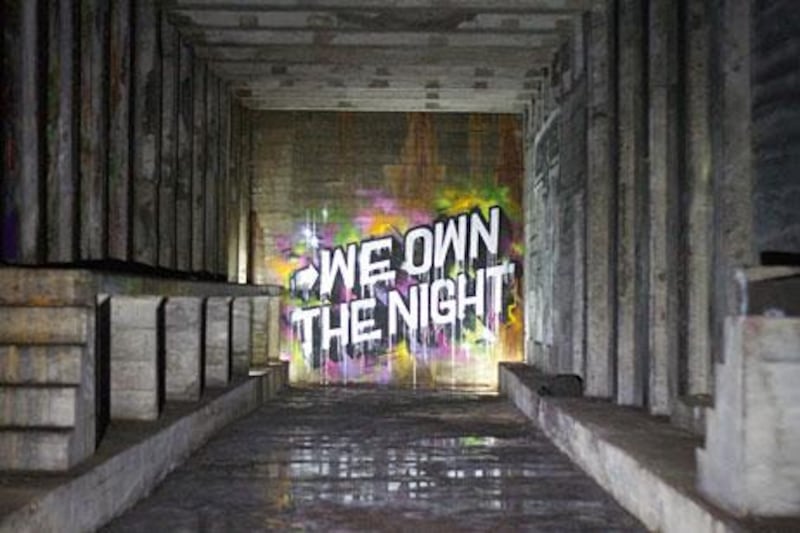I am at the opening of a swanky new gallery. Around me, the latest daubs by the hottest of names adorn the walls of room after room. Rarely can new art worth so many millions of dollars have been unveiled in one space on one night. And in such a sizzling location.
I should mention a couple of differences from your regular opening, the odd divergence from standard practice. This is a canapé-free environment, for one. There is neither chilled white wine nor any pretentious appraisal of carefully lit works. No discreet red stickers identify those exhibits already sold for untold thousands. No one has come dressed to thrill.
In fact no one has come at all. Apart from me.
Indeed, I am the only person on the planet who will ever be invited to view the complete collection. And it's not as if I'm even a guest. I am here as an independent witness to testify that this place exists, that it is not one of those elaborate art hoaxes mocked up in a studio. Someone could make untold sums charging entry. The queues would stretch round the block. However, that is not part of the plan. After tonight, the gallery will be sealed off forever, and all the art entombed within.
This is the opening night, but it's also the closing night.
It is for this reason that I can't say where I am. The location is entirely top secret. OK, I'm in New York. New York City, to be specific. But that is it. I can give nothing more away. Why? Because what I am about to describe is illegal. Totally and utterly illegal. Welcome to the Underbelly Project, an artistic venture of towering ambition, matchless audacity and sheer bloody wonderful cheek.
We muster at street level. Me, a couple of gents in arty fatigues, and a camerawoman.
Naturally, I can't say where the rendezvous point is but it's on a corner next to a diner. It is still light and warm when we turn and head down into the subway. We are careful not to acknowledge one another's presence as a train pulls in. At the next stop we alight. In the interests of security, I am not at liberty to describe the station. There are subway buffs out there who could identify the line from the colour of the tiles. They're called "foamers" because they froth rabidly at the mouth at all forms of subway stuff.
"This project," advises Workhorse, "will probably be like crack to the foamers." Workhorse - not his real name - is one of my guides into the underworld. In the vagabond art form known as street art, whose practitioners are used to dodging the law and shrouding their identity behind a nom de guerre, he is a huge figure.
He and PAC, a slightly younger and leaner street artist, have been toiling away at the Underbelly Project for 18 months. Between them they've made perhaps 75 visits to the site. This is to be the last. After tonight, the only evidence, their only connection to the place, will be in the form of photographs and film. Both men are jittery with tension. If they get through tonight, they will have successfully brought more than a hundred artists to the site, undetected and unprosecuted. For a couple of slacker-dude outsider types, not obvious inheritors of the military-precision gene, it's been quite an undertaking.
It being a Sunday and the station stop not slap bang in the centre of Manhattan, the platform gradually empties. Workhorse leads us to the entrance. I'm told to walk 10 metres behind him. In seconds I enter a world that most New Yorkers never see, or even know about.
My pulse races. We clamber over obstacles until we are in an empty space. In the dark, lit by our torches, it's more like a concrete cave. PAC, who is carrying a powerful square-shaped, multi-bulb floodlight, fires it up, hoists it onto his hip and directs it out front. And there, suddenly irradiated in the beam, is the ghost of a subway station. It's overwhelmingly vast, all square pillars and lowering ceiling. The light collides with colonnades of grey struts stretching all the way back to a far wall. I take in the spectral contours of the space: empty beds where railway tracks were never laid, access points where staircases were never built, hollow drops where escalators were never fitted and platforms where passengers never waited for trains.
But hold on, there in the distance the beam catches a lurid flash of colour. It swerves onto another. Floor-to-ceiling images adorn distant walls, much like posters on subway platforms. Here, apparently, is artwork after outsize artwork. It feels as if I've stumbled into the 21st-century equivalent of the caves at Lascaux. Instead of drawings of Palaeolithic quadrupeds, scrawled onto walls 17,000 years ago, there are lurid images that carbon-date the work to right here, right now. At a glance, I can see gawping heads, writhing figures, letter clusters in signature graffiti fonts, riotous splashes and swooshes of attention-seeking colour.
And we haven't even scratched the surface. This contemporary time capsule features 100 works of street art by artists from all over the world. There is no Guggenheim Museum for a fugitive art form whose works are sprayed and pasted on public walls in the dead of night. Instead, all of a sudden, there's this: a renegade installation planted furtively under one of the busiest cities in the world. I have never seen anything like it. Nor has anyone else. And here's the thing: nor will they. But why on earth would anyone create something on such a scale that nobody else will ever get to see?
It's Workhorse who pipes up with an oral version of their manifesto.
"In the beginning," he says, "street art was something you did because you didn't fit in anywhere else. But for the last few years urban art was getting ridiculous. You could go out with some cute little character that you drew, or some quirky saying, and put it up everywhere for a few months, then do a gallery show and cash in on the sudden interest in urban art. It really was that easy for a while. Banksy pieces that were selling for $600 (Dh2,200) one year were suddenly selling for $100,000 (Dh367,000) a few years later. It was commercialism at its worst. The Underbelly was our way of feeling like we were an island again. We finally had a space in the world that collectors couldn't contaminate. A space that couldn't be bought."
Art, in other words, for art's sake.
Workhouse seems a benign type, but there's no missing the punkish inner rage that fuels him. PAC, an even more hardline advocate of creative cleanliness, was all for not publicising the existence of Underbelly at all. "But we can't just put in a year and a half and deny the fact that we did something like this," he says.
We are almost whispering. Sound reverberates in this hollow chasm, and can escape through cavities to places where it might be heard. The regular clatter of trains thundering past sometimes muffles our voices altogether. Light streaks across the walls of the site like film being fed slowly through a projector, scattering transitory illumination across eerie works that will never be seen in the light.
The New York Subway is home to a considerable labyrinth of abandoned spaces that were once destined to become stations and, for whatever reason, never made it. Most are known only to a renegade band of urban explorers: people who stop at nothing to seek out the city's desolate nooks and crannies.
It was one of these types who introduced PAC to the station in 2005. "I would hang out here for hours at a time as somewhere to get inspiration," he says, "enjoy the architecture, enjoy the solitude of being underground." Then he met Workhorse, a theme of whose work is reclaiming abandoned spaces. "I told him I knew about a space that was pretty cool, brought him down here, and that night the idea for the project hatched."
The Underbelly Project took on epic proportions as soon as they realised that they and a few friends couldn't possibly hope to cover the walls by themselves. So they decided to put the word out in urban art's clandestine community: they'd stop after a year, or when they reached 100 works, whichever came first.
At that point they didn't quite know how much labour they'd let themselves in for. So they imposed a time limit. Four hours to work. No exiting for more materials. No coming back. Artists also had to pay their own expenses - including air travel - and generally subsume their ego to the wider mission. Naturally there was no talk of remuneration.
"We said: 'You have to do this out of interest and love for what we're doing. This is not about you basically'," says Workhorse.
Among the stellar urban artists who give the Underbelly Project its credibility is Ron English, who can shift his work above ground for $70,000 (Dh257,000). Swoon, a Brooklyn urban-art activist, made waves at last year's Venice Biennale when, uninvited, she sailed a floating cityspace sculpture made of rubbish down the Grand Canal at 3am.
"We tried to make sure we had a true cross section of what's going on, not just current favourites: old-school guys, new-school guys, up and coming guys, and plenty of girls," says Workhorse. (Ten female artists came down by their reckoning.) They were from all over: Japan, Canada, Australia, France, Mexico, Spain, the UK. PAC was approached by a Romanian artist looking for an opening in New York. "I looked at his work and said: 'Why don't you come do a piece for this project I've got going on?'"
But most were fellow Americans appropriately, given the origins of the modern urban art movement in 1970s New York, when graffiti artists started covering subway trains with their tags (graffiti argot for a signature). In the 1980s, the work of street artists such as Jean-Michel Basquiat and Keith Haring (both dead by 1990) took the movement off the walls of Manhattan and into galleries, museums, and, above all, auction houses.
For two and a half hours I take the tour, Workhorse and PAC walking me past each piece. They fall eclectically into the three main schools of "what's happening upstairs", as they put it: graffiti-style tagging, street art and urban installation. The work ranges from simple statement to dense allusion, from vast and bold, lurid and Day-Glo to subtle and pernickety, intricate and arcane.
Some works are shiny with childlike rainbow-coloured optimism. One artist has counterintuitively daubed a huge red-and-white flower up the wall, as if anything could grow down here. But the pieces that grab me are the ones that are more sinisterly in sync with the space - skulls and creepy profiles, Hadean spectres and a pair of huge rats.
There is an expected amount of anarchic sloganeering and sly digs at the corporate-commercial complex. "WE OWN THE NIGHT," blares one painting on an end wall in italicised upper case. Another is plastered in a woozy, zig-zagged Stars and Stripes banner.
Workhorse reserved a cinemascopic space and created a minutely detailed, stencil-based image of himself in an empty subway carriage. "I just had the idea of this ghost train passing through the station for all of eternity, me sitting here."
PAC's piece, done in a small boxlike space, plays cleverly on the damp atmosphere: an intoxicating trompe l'oeil of black and white rhomboids whose careful patterning has been disfigured by sliding drips of paint.
Mostly the artists came down in ones and twos and occasionally fours, donned their face masks and head torches and set to work. It didn't always go smoothly. "Just as we were packing up to leave one night," says PAC, "I heard some noises, looked down on the platform, and workers were setting up to do serious track work. So we sat in the pitch black for four hours while these guys sawed steel, and Ron English paced back and forth yelling about picking his kid up from soccer practice. It turned into the longest night."
It's not a pleasant place to hang out in the pitch black. We are nearing the end of my guided tour. I've just been looking at another outlandish sprawl when Workhorse pipes up. "So, try to imagine if you come here and you have no idea where your orientation is, and you come up on this place and find that." And he suddenly flicks a torch beam onto a small hooded figure in jeans crouching against the wall. I jump out of my skin. Turns out it's a body sculpture made of tape. I lean in close and note that the maquette face already has mould growing on it.
Which prompts the question. How long can this time capsule of urban art last? Plainly there's the fear that it will be disinterred and destroyed by law enforcement officials sent down to investigate by the Metropolitan Transportation Authority. But time and humidity are already working away at the poster images fixed to the wall with organic wheat paste. One thickly sprayed painting has simply never dried. They reckon the painted works will last two or three decades. "I like the fact that by the time somebody figures out where this is and gets in," says PAC, "it'll be apocalyptic because things will be deteriorating and it'll be this memory."
Our time is up. We are back where we started, at the exit point. A creative venture of unimaginable scale requiring a massive commitment of time, energy, focus and, above all, secrecy has finally been completed. We've still got to get out without being spotted, and this time they're removing access to the site. Workhorse is still tense, and not quite ready for celebration. PAC is more reflective when I ask him how he feels to be leaving.
"It's time to seal it up," he says."Every time I walk over a subway grate and smell that air coming up I'll remember this station."
We clamber out much as we clambered in. This time they hurriedly destroy the means of egress. And then we exit as we entered, in single file, 10 metres apart. The platform is deserted. After a few minutes a train pulls in and we step on, travel one stop, get off, and saunter up a flight of stairs into the teeming, broiling, honking New York night. Nobody knows. Literally. Nobody up here knows…
Check out some of the team's work at www.theunderbellyproject.com





